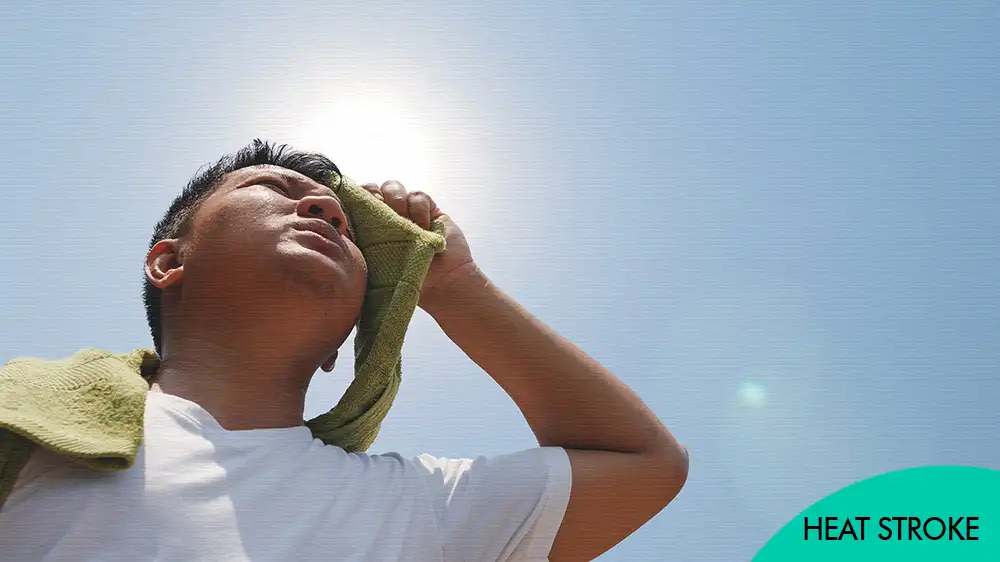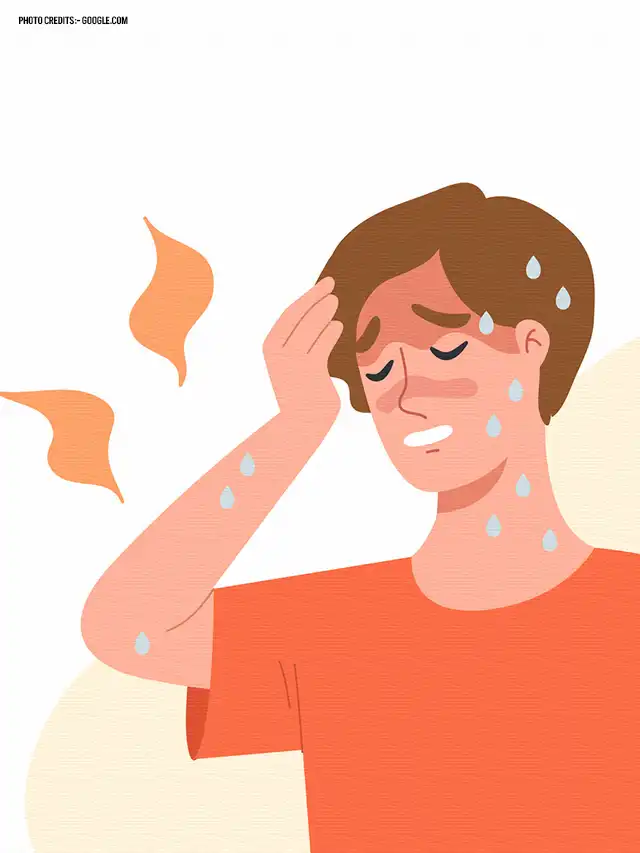
HEALTH BLOG
Heat Stroke: Causes, Symptoms, Treatment and Difference
-
 Rahul Priydarss
Rahul Priydarss - April 11, 2024
Learn about the profound impact of climate change on heat stroke incidents. Discover how rising temperatures, prolonged heat waves, and shifts in geographic distribution are contributing to increased risks. Explore adaptation strategies and the importance of climate action in mitigating heat-related illnesses.
Introduction to Heat Stroke:
Heat stroke is a serious medical condition that occurs when the body’s temperature regulation system becomes overwhelmed by excessive heat. It is considered a medical emergency and can be life-threatening if not treated promptly. Heat stroke typically occurs when the body’s core temperature rises to 104°F (40°C) or higher.
In hot weather conditions or during strenuous physical activity, the body relies on mechanisms such as sweating and blood vessel dilation to dissipate heat and maintain a normal body temperature. However, in cases of prolonged exposure to high temperatures or humidity, these mechanisms may be inadequate, leading to heat-related illnesses, including heat stroke.

Table of Contents
Causes of Heat Stroke:
Heat stroke occurs when the body’s ability to regulate its temperature is overwhelmed by external heat or internal factors. Several factors can contribute to the development of heat stroke, including.
1. Environmental Factors:
High Temperatures: Exposure to prolonged periods of hot weather, especially during heatwaves, increases the risk of heat stroke.
High Humidity: High levels of humidity make it more difficult for sweat to evaporate from the skin, impairing the body’s natural cooling mechanism.
Lack of Air Circulation: Stagnant air or poor ventilation can prevent the dissipation of heat, leading to overheating.
2. Physical Exertion:
Strenuous Activity: Engaging in intense physical activity, especially in hot environments, can raise the body’s core temperature rapidly, increasing the risk of heat stroke.
Overexertion: Pushing the body beyond its limits, such as during prolonged exercise sessions or manual labor in the heat, can lead to heat-related illnesses, including heat stroke.
3. Individual Factors:
Dehydration: Inadequate fluid intake or excessive fluid loss through sweating can impair the body’s ability to regulate temperature and increase the risk of heat stroke.
Medical Conditions: Certain medical conditions, such as cardiovascular disease, diabetes, obesity, and respiratory conditions, can make individuals more susceptible to heat-related illnesses, including heat stroke.
Medications: Some medications, such as diuretics, antihistamines, beta-blockers, and stimulants, can interfere with the body’s ability to regulate temperature or increase sensitivity to heat, increasing the risk of heat stroke.
4. Behavioral Factors:
Clothing Choices: Wearing tight, dark-colored clothing or clothing that traps heat can contribute to overheating and increase the risk of heat stroke.
Alcohol and Drug Use: Alcohol and certain drugs can impair judgment, leading individuals to underestimate the effects of heat or engage in risky behaviors that increase the risk of heat-related illnesses.
Symptoms of Heat Stroke:
Heat stroke is a serious medical condition characterized by a rapid and significant increase in body temperature, typically exceeding 104°F (40°C). It can lead to severe complications if not treated promptly. Recognizing the symptoms of heat stroke is crucial for seeking immediate medical attention. Common symptoms include.
1. High Body Temperature:
The body temperature rises to 104°F (40°C) or higher, indicating a critical state of overheating.
2. Altered Mental State:
Confusion: Individuals may appear disoriented or have trouble thinking clearly.
Agitation: Restlessness or irritability may be present.
Delirium: In severe cases, individuals may experience hallucinations or loss of consciousness.
3. Rapid Heart Rate and Breathing:
Tachycardia: The heart rate increases as the body attempts to cool itself down.
Tachypnea: Breathing becomes rapid and shallow as the body struggles to maintain oxygen levels.
4. Flushed Skin:
Hot and Dry Skin: The skin may feel hot to the touch and appear flushed or red, with decreased sweating in some cases.
Profuse Sweating: In some instances, individuals may experience excessive sweating as the body attempts to cool down, especially during the early stages of heat stroke.
5. Nausea and Vomiting:
Gastrointestinal Symptoms: Nausea, vomiting, and abdominal discomfort may occur as a result of heat exposure and dehydration.
6. Headache and Dizziness:
Throbbing Headache: Severe headaches are common during heat stroke and may be accompanied by dizziness or lightheadedness.
7. Fatigue and Weakness:
Exhaustion: Individuals may feel extremely tired or weak, with diminished physical and mental energy.
8. Loss of Coordination:
Ataxia: Coordination and balance may be impaired, leading to difficulty walking or performing tasks.
9. Seizures:
Muscle Twitching: In severe cases, heat stroke can trigger seizures or convulsions due to neurological dysfunction.
10. Unconsciousness:
Fainting: Loss of consciousness may occur as a result of severe heat-related complications.
Treatment of Heat Stroke:
Heat stroke is a medical emergency that requires immediate intervention to prevent serious complications, including organ damage and death. The primary goals of treatment are to rapidly lower the body temperature and provide supportive care. The following steps outline the treatment approach for heat stroke.
1. First-Aid Treatment:
Move to a Cooler Environment: Immediately move the individual to a shaded or air-conditioned area to reduce exposure to heat.
Remove Excess Clothing: Loosen or remove tight clothing to allow heat to dissipate from the body more effectively.
Cooling Measures: Apply cool water to the skin using damp towels, spray mist, or immerse the individual in a cool bath or shower. Evaporation of water helps lower the body temperature.
Use of Cold Packs: Apply cold packs or ice packs to areas with high blood flow, such as the neck, armpits, and groin, to facilitate rapid cooling.
2. Hydration:
Fluid Replacement: Provide cool water or oral rehydration solutions to replenish fluids lost through sweating and prevent dehydration.
Avoid Alcohol and Caffeine: Encourage the individual to avoid alcohol and caffeine, which can worsen dehydration.
3. Medical Evaluation and Support:
Monitor Vital Signs: Continuously monitor the individual’s vital signs, including body temperature, heart rate, blood pressure, and respiratory rate.
Medical Assessment: Seek emergency medical assistance immediately. Heat stroke requires prompt evaluation and treatment by healthcare professionals.
Intravenous Fluids: In severe cases of heat stroke or dehydration, intravenous fluids may be administered to restore electrolyte balance and support circulation.
Other Medical Interventions: Depending on the severity of symptoms and complications, additional medical interventions may be necessary, such as oxygen therapy, cardiac monitoring, or treatment for seizures.
4. Preventive Measures:
Prevent Recurrence: Once the individual’s condition stabilizes, take steps to prevent recurrence of heat-related illnesses. This may include avoiding further exposure to heat, staying hydrated, and modifying activities during hot weather conditions.
Educational Counseling: Provide education on heat stroke prevention strategies, including recognizing early warning signs, staying hydrated, wearing appropriate clothing, and taking breaks in shaded or air-conditioned areas.

How to Avoid Heat Stroke:
Preventing heat stroke involves taking proactive measures to minimize exposure to high temperatures and staying hydrated during hot weather or strenuous activities. Here are some strategies to help you avoid heat stroke.
1. Stay Hydrated:
Drink Plenty of Fluids: Stay hydrated by drinking water regularly, even if you don’t feel thirsty. Avoid sugary or alcoholic beverages, as they can contribute to dehydration.
2. Dress Appropriately:
Wear Lightweight Clothing: Choose lightweight, loose-fitting clothing in light colours to reflect sunlight and help keep your body cool.
Protective Gear: If engaging in outdoor activities, wear a wide-brimmed hat, sunglasses, and sunscreen to protect against sunburn and minimize heat absorption.
3. Time Outdoor Activities Wisely:
Avoid Peak Heat Hours: Limit outdoor activities during the hottest parts of the day, typically between 10 a.m. and 4 p.m. If possible, schedule outdoor activities for the early morning or late afternoon when temperatures are cooler.
4. Seek Shade or Cool Environments:
Take Breaks: Take frequent breaks in shaded or air-conditioned areas to rest and cool down during outdoor activities.
Use Fans or Air Conditioning: If indoors, use fans or air conditioning to maintain a comfortable temperature and promote air circulation.
5. Pace Yourself:
Avoid Overexertion: Pace yourself during physical activities, especially in hot environments. Take regular breaks and listen to your body’s signals of fatigue or overheating.
6. Acclimate to Heat:
Gradually Increase Activity: If you’re not accustomed to hot weather or strenuous activity, gradually increase your level of exertion over time to allow your body to acclimate to the heat.
7. Stay Informed:
Monitor Weather Conditions: Stay informed about weather forecasts and heat advisories in your area. Take extra precautions during periods of extreme heat or heatwaves.
8. Know the Warning Signs:
Recognize Symptoms: Familiarize yourself with the signs and symptoms of heat-related illnesses, including heat exhaustion and heat stroke. Seek medical attention immediately if you or someone else shows signs of heat stroke.
9. Take Care of Vulnerable Individuals:
Check on Others: Keep an eye on vulnerable individuals, such as the elderly, young children, and those with chronic medical conditions, during hot weather. Offer assistance and support as needed.
10. Stay Cool Indoors:
Use Cooling Devices: Use fans, air conditioning, or cooling towels to lower indoor temperatures and create a comfortable environment during hot weather.
Differences Between Heat Exhaustion and Heat Stroke:
Heat exhaustion and heat stroke are both heat-related illnesses, but they differ in their severity, symptoms, and treatment. Understanding the distinctions between the two conditions is crucial for proper management and intervention. Here are the key differences.
1. Severity:
Heat Exhaustion: Heat exhaustion is considered a milder form of heat-related illness. It typically develops gradually and can progress to heat stroke if left untreated.
Heat Stroke: Heat stroke is a severe and life-threatening condition characterized by a rapid and significant increase in body temperature. It is considered a medical emergency and requires immediate treatment.
2. Core Body Temperature:
Heat Exhaustion: The body temperature may be elevated, but it usually remains below 104°F (40°C).
Heat Stroke: Heat stroke is defined by a core body temperature of 104°F (40°C) or higher.
3. Symptoms:
Heat Exhaustion: Symptoms of heat exhaustion may include heavy sweating, weakness, fatigue, dizziness, nausea, headache, and pale or clammy skin. Individuals with heat exhaustion may also experience thirst and muscle cramps.
Heat Stroke: Symptoms of heat stroke are more severe and may include a high body temperature (above 104°F or 40°C), altered mental state (confusion, agitation, hallucinations), rapid pulse, rapid breathing, flushed or red skin, lack of sweating, nausea and vomiting, headache, and loss of consciousness.
4. Sweating:
Heat Exhaustion: Individuals with heat exhaustion typically continue to sweat profusely as the body attempts to cool down.
Heat Stroke: Sweating may be absent or significantly reduced in individuals with heat stroke, leading to dry, hot, and flushed skin.
5. Treatment:
Heat Exhaustion: Treatment for heat exhaustion involves moving the individual to a cooler environment, providing hydration, resting, and cooling the body with cool water or cold packs. Medical evaluation may be necessary if symptoms persist or worsen.
Heat Stroke: Heat stroke requires immediate medical attention. Treatment involves rapid cooling of the body, intravenous fluids to rehydrate and support circulation, and monitoring for complications such as organ damage or seizures.
6. Prognosis:
Heat Exhaustion: With prompt intervention and appropriate treatment, individuals with heat exhaustion typically recover fully without lasting effects.
Heat Stroke: Heat stroke can lead to serious complications, including organ damage, neurological deficits, and death, if not treated promptly and effectively.
Misconceptions About Heat Stroke:
Despite being a well-known heat-related illness, there are several misconceptions surrounding heat stroke. Clarifying these misconceptions is essential for raising awareness and promoting an accurate understanding of the condition. Here are some common misconceptions.
1. Heat Stroke Only Occurs in Extremely Hot Weather:
Reality: While hot weather can increase the risk of heat stroke, it can occur in various settings, including indoors, during physical activity, or in humid environments. Prolonged exposure to high temperatures, especially without adequate hydration and cooling measures, can lead to heat stroke.
2. Heat Stroke Only Affects the Elderly:
Reality: While older adults are more susceptible to heat-related illnesses, heat stroke can affect individuals of all ages, including young children, athletes, and individuals with pre-existing medical conditions. Anyone exposed to excessive heat without proper precautions is at risk.
3. Heat Stroke Always Causes Sweating:
Reality: While sweating is a common symptom of heat-related illnesses, including heat exhaustion, it may not occur in cases of severe heat stroke. Heat stroke can lead to a cessation of sweating, resulting in dry, hot skin. Lack of sweating does not rule out the possibility of heat stroke.
4. Heat Stroke Only Happens During Outdoor Activities:
Reality: While outdoor activities in hot weather increase the risk of heat stroke, it can occur in various settings, including indoors, workplaces, vehicles, and homes without adequate cooling. Excessive heat exposure, combined with factors such as dehydration and poor ventilation, can contribute to heat stroke in any environment.
5. Heat Stroke Is Always Accompanied by Red Skin:
Reality: While flushed or red skin is a common symptom of heat stroke, it may not always be present, especially in cases of dehydration or heat stroke with a lack of sweating. Skin color alone is not a reliable indicator of heat stroke, and other symptoms should also be considered.
6. Heat Stroke Is Always Preventable:
Reality: While preventive measures can reduce the risk of heat-related illnesses, including heat stroke, it is not always entirely preventable, especially in extreme heat conditions or for individuals with certain medical conditions. However, awareness of risk factors, early recognition of symptoms, and prompt intervention can significantly reduce the likelihood of heat stroke and its complications.
7. Heat Stroke Only Occurs in Summer:
Reality: While heat-related illnesses are more common during the summer months, heat stroke can occur at any time of the year, especially in regions with hot climates or indoor environments with inadequate cooling. Heat stroke can also occur during heatwaves, prolonged heat exposure, or during strenuous physical activity.
Impact of Climate Change on Heat Stroke Incidents:
Climate change is having a significant impact on the frequency, intensity, and duration of heat waves, leading to an increase in heat-related illnesses, including heat stroke. Here are some ways in which climate change is influencing heat stroke incidents.
1. Rising Temperatures:
Increased Heat Exposure: Climate change is causing temperatures to rise globally, leading to more frequent and intense heat waves. Higher temperatures increase the risk of heat-related illnesses, including heat stroke, especially among vulnerable populations.
2. Prolonged Heat Waves:
Extended Duration: Climate change is resulting in longer-lasting heat waves, with periods of extreme heat persisting for longer periods. Prolonged heat exposure increases the likelihood of heat-related illnesses, as individuals may struggle to find relief from high temperatures.
3. Urban Heat Island Effect:
Exacerbated in Cities: The urban heat island effect, exacerbated by climate change, leads to higher temperatures in urban areas compared to surrounding rural areas. This phenomenon can contribute to an increased risk of heat-related illnesses, including heat stroke, among urban populations.
4. Impact on Vulnerable Populations:
Disproportionate Impact: Vulnerable populations, such as the elderly, children, low-income communities, and those with pre-existing health conditions, are disproportionately affected by heat-related illnesses. Climate change exacerbates existing health disparities, increasing the risk of heat stroke among these groups.
5. Shifts in Geographic Distribution:
Expansion of Affected Regions: Climate change is causing shifts in the geographic distribution of heat waves, with traditionally cooler regions experiencing more frequent and intense heat events. This expansion of affected regions exposes new populations to the risks of heat-related illnesses, including heat stroke.
6. Impacts on Infrastructure and Resources:
Strain on Healthcare Systems: An increase in heat-related illnesses, including heat stroke, places strain on healthcare systems, emergency services, and public health resources. Hospitals and healthcare facilities may experience increased demand for medical services during heat waves.
7. Adaptation and Mitigation Efforts:
Need for Adaptation Strategies: Climate change adaptation strategies, such as heat wave preparedness plans, early warning systems, and public education campaigns, are essential for reducing the impact of heat-related illnesses, including heat stroke. These efforts aim to increase resilience and protect vulnerable populations from the health risks associated with rising temperatures.
8. Importance of Climate Action:
Addressing Root Causes: Addressing the root causes of climate change through mitigation efforts, such as reducing greenhouse gas emissions and transitioning to renewable energy sources, is crucial for preventing further increases in heat-related illnesses. Taking action to mitigate climate change can help protect public health and reduce the incidence of heat stroke in the future.
FAQs about Heat Stroke:
A1: Yes, heat stroke can occur indoors if the environment is poorly ventilated or lacks air conditioning, especially during heat waves.
A2: Heat stroke can develop rapidly in as little as 10 to 15 minutes, particularly in high temperatures and humidity.
A3: While the terms are sometimes used interchangeably, sunstroke specifically refers to heat stroke caused by prolonged exposure to direct sunlight.
A4: Yes, medications such as diuretics, antihistamines, and beta-blockers can impair the body’s ability to regulate temperature and increase the risk of heat-related illnesses.
A5: If you suspect someone has heat stroke, immediately move them to a cooler environment, remove excess clothing, and apply cool water or ice packs to their body. Seek medical help promptly.

-Please remember, to always consult with healthcare professionals or Doctors for personalised advice related to medical conditions.
Conclusion:
In conclusion, heat stroke is a severe medical condition that demands immediate attention when the body’s temperature regulation system fails due to excessive heat exposure. Recognizing its symptoms and risk factors, providing prompt treatment, and implementing preventive measures are crucial steps in mitigating its impact. With rising global temperatures due to climate change, understanding and addressing the factors contributing to heat stroke incidents become increasingly vital for public health.




